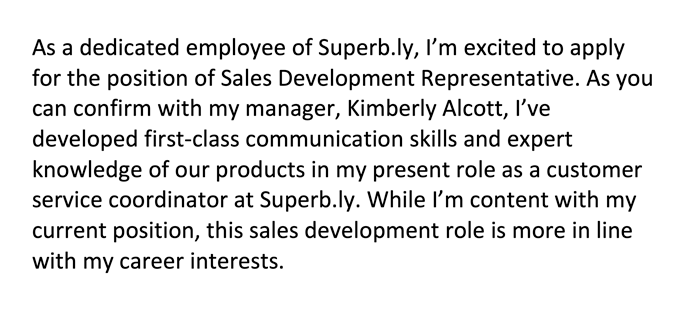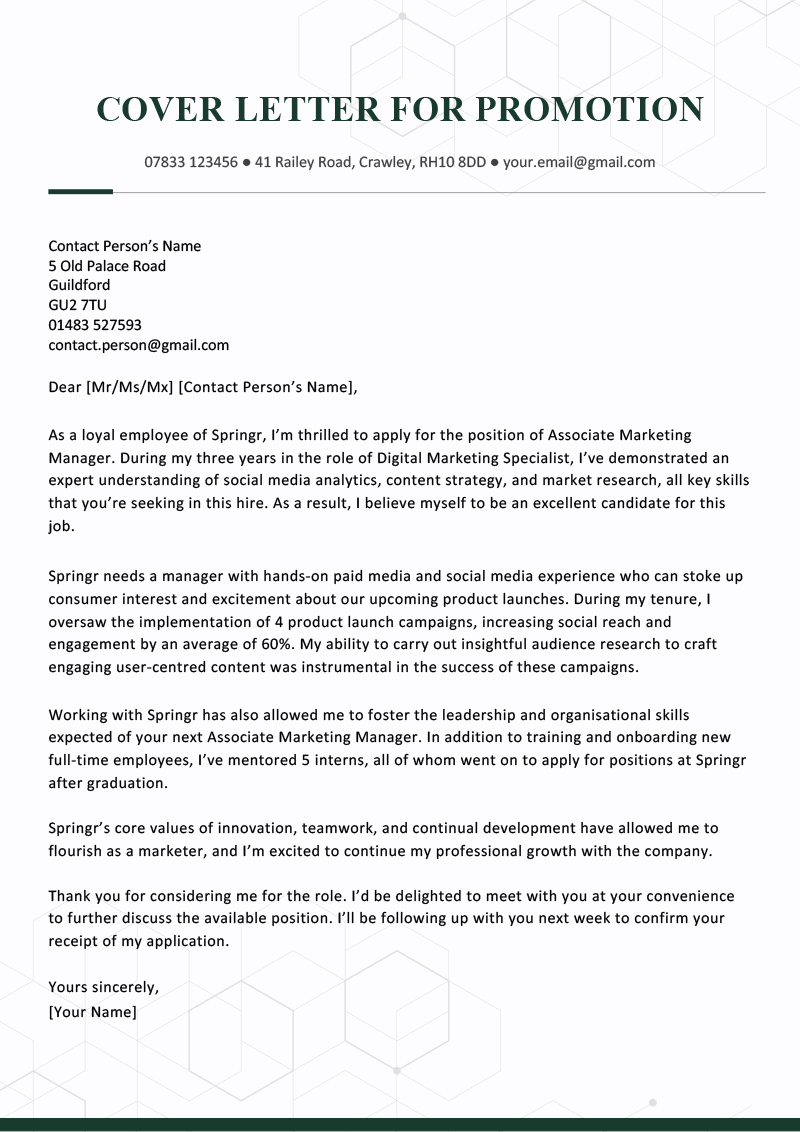You don’t have to hop from company to company to move up the career ladder — even if that’s what most employees mistakenly believe.
A great job opportunity might be available at the place you already work.
But for your internal application to be a success, you’ll need to make a cover letter — whether you’re pursuing a promotion or a transfer to another department.
The key to writing the best cover letters is to tell the employer why you’ll excel at the job and your reasons for applying.
The same is true of writing a cover letter for internal positions.
But as you already work for the hiring company, there are some key differences between how you should handle an internal application and how you write a cover letter normally.
Ready to move through the ranks? In this article, we’ll cover what an internal cover letter is, what to include in your letter, and how to take advantage of your current position within the company.
Don’t forget — you’ll also need to write a CV for an internal position or promotion! And if you’ve been promoted before, learn how to show promotions on your CV to convey your career progression clearly.
What’s different about a cover letter for an internal position?
When you apply for an internal position, you already work for the hiring company. This gives you a couple of important advantages over external candidates:
- You know more about the position, culture, and work environment
- The employer knows you already, or they can find out about you by asking their colleagues
This will affect how you start your cover letter. For example, if you work for a small company or already know the hiring manager, it may not be necessary to introduce your current position — especially if you’re applying for a promotion.
Instead, your introduction should outline your career plans within the company. You can do this by teasing some of the skills or experiences that have prepared you for the role’s responsibilities.
You should also use your knowledge of the company to align yourself with its core values.
Writing cover letters for a promotion vs internal transfer
How you should write your internal cover letter depends on what kind of transfer you’re applying for.
If you’re writing a cover letter for a promotion, you should focus on underlining your excellent performance in your current role and demonstrate how this performance has prepared you to take on greater responsibilities.
If applying for an internal transfer, focus on hard skills (job-specific abilities) and soft skills (character traits) that transfer well between your current job and the job you hope to get.
For example, if you were hoping to move from a sales role to a marketing role, you could highlight transferable skills like community outreach skills and written communication to show the hiring manager how you’d excel as a member of their team.
You should also make a CV highlighting the same transferable skills. But remember to expand on those skills in your cover letter, rather than just repeating the information you put your CV.
Cover letter for promotion example
Here’s an example cover letter for a promotion that demonstrates how the applicant’s current role has prepared them for increased responsibility.
Cover letter for promotion example (text version)
Contact Person’s Name
5 Old Palace Road
Guildford
GU2 7TU
01483 527593
contact.person@gmail.com
Dear [Mr/Ms/Mx] [Contact Person’s Name],
As a loyal employee of Springr, I’m thrilled to apply for the position of Associate Marketing Manager. During my three years in the role of Digital Marketing Specialist, I’ve demonstrated an expert understanding of social media analytics, content strategy, and market research, all key skills that you’re seeking in this hire. As a result, I believe myself to be an excellent candidate for this job.
Springr needs a manager with hands-on paid media and social media experience who can stoke up consumer interest and excitement about our upcoming product launches. During my tenure, I oversaw the implementation of 4 product launch campaigns, increasing social reach and engagement by an average of 60%. My ability to carry out insightful audience research to craft engaging user-centred content was instrumental in the success of these campaigns.
Working with Springr has also allowed me to foster the leadership and organisational skills expected of your next Associate Marketing Manager. In addition to training and onboarding new full-time employees, I’ve mentored 5 interns, all of whom went on to apply for positions at Springr after graduation.
Springr’s core values of innovation, teamwork, and continual development have allowed me to flourish as a marketer, and I’m excited to continue my professional growth with the company.
Thank you for considering me for the role. I’d be delighted to meet with you at your convenience to further discuss the available position. I’ll be following up with you next week to confirm your receipt of my application.
Yours sincerely,
[Your Name]
Cover letter for internal position example
If you’re applying to transfer to another position in the company, you’ll want to show the employer that your target position is better aligned with your career goals. One way to do this is by highlighting important transferable skills that you mastered in your current role, as with this example:
Cover letter for promotion example (text version)
Contact Person’s Name
1 Petersfield Avenue
Slough
SL2 5EA
(01753) 1234-567
contact.person@gmail.com
Dear [Mr/Ms/Mx] [Contact Person’s Name],
As a dedicated employee of Superb.ly, I’m excited to apply for the position of Sales Development Representative. As you can confirm with my manager, Kimberly Alcott, I’ve developed first-class communication skills and expert knowledge of our products in my present role as a customer service coordinator at Superb.ly. While I’m content with my current position, the sales development role is more in line with my career interests.
I see you’re seeking a candidate with hands-on experience in sales activities such as nurturing and retaining leads. I handle 90+ calls a day for Superb.ly’s customer service department and have an average customer satisfaction rate of 85%, among the highest in my team. My excellent verbal communication and interpersonal skills would make me an excellent first point of contact for prospective customers, as demonstrated by my spotless record addressing customer queries.
Superb.ly’s plans to expand its operations in Europe align perfectly with my own goals within this company. With a BA in German with French, I’ve been seeking an opportunity to apply my language skills to my profession and am eager to take on the responsibilities involved, including travel.
Given my knowledge of both the company and the markets in which you’re expanding, I believe myself to be an excellent candidate for this role. It has been a privilege to work with Superb.ly, and I look forward to discussing this opportunity with you further at your convenience. I’ll follow up with you next week to confirm your receipt of my application.
Yours sincerely,
[Your Name]
How to write a good cover letter for an internal position
Wondering how to word a cover to secure an internal position? We’ll guide you through the process.
1. Write a strong introduction
Writing a cover letter introduction for an internal position differs from how you’d write one for a job at a different company.
While you’d normally start a cover letter by giving your name and work history and outlining your qualifications for the job, the content of an internal cover letter introduction should reflect how well you know the hiring manager.
If you’ve worked with the hiring manager before, it’s not necessary to introduce yourself in full.
A more effective approach is to write a short cover letter outlining your career goals, your commitment to the company, and how taking the role serves you in your career.
This introduction would suit a cover letter for an internal position in a small or large company:

The applicant states that they’re already an employee of Superb.ly and highlights their commitment to the company.
They also highlight two key skills for the hiring position, which tailors their letter to the job and helps their application stand out.
Giving the name of a manager or supervisor will make your application more credible — though only do this if you’ve discussed the transfer with your manager first.
2. Outline your qualifications
As with any cover letter, your second paragraph should convince the hiring manager your relevant work experience and skills make you the best candidate for the position.
If you’re applying to transfer to a different area of the company, highlight hard skills and soft skills you’ve developed in the new position.
If you’re applying for a more senior position, you should also show how your hard and soft skills have prepared you to take on greater responsibilities.

Including numbers will make your cover letter more specific and easier to read. For example, the applicant above says that they handle 90+ calls daily, so the hiring manager can immediately grasp their responsibilities within the company.
The applicant also does an excellent job of highlighting soft skills, such as communication and interpersonal skills, which are important to both customer service and sales roles. Demonstrating strong relevant soft skills demonstrates to the manager that you’d excel in your new role.
3. Explain why you want to make the move
When applying for an internal position, it’s important to create a strong narrative to convince the hiring manager you’re not only well qualified for the position but eager to grow with the company.
Regardless of the industry, employers look for candidates who stick around and provide a good return on investment for the company.
Showing the hiring manager your long-term career goals align with the company will reassure them you’re the kind of employee worth investing in.

Use your knowledge of the company to your advantage.
In the example above, the applicant uses the company’s plans to expand into foreign markets to demonstrate how some of their untapped skills will be useful moving forward.
They also align their career goals with a company objective.
You may use company values, work culture, or the targets and objectives of the hiring team to justify your desire for an internal transfer.
4. Make a positive closing statement
While your goal is to change jobs, you also want to demonstrate your commitment to the company.
Finish your cover letter by expressing gratitude for your current position, asserting the value of the open position to your career plans, and the benefits you can offer the hiring team.
Show eagerness to discuss the position further and let the hiring manager know you’ll follow up on your application.
A positive attitude about your current job and readiness to take on new responsibilities will reflect well on you as an employee and show loyalty.







